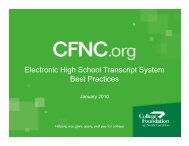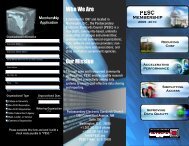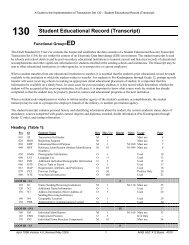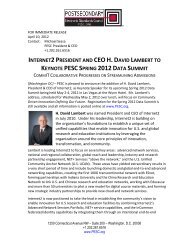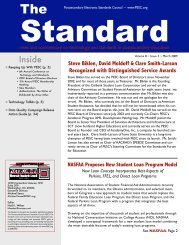February 2013 - PESC
February 2013 - PESC
February 2013 - PESC
You also want an ePaper? Increase the reach of your titles
YUMPU automatically turns print PDFs into web optimized ePapers that Google loves.
8<br />
In 2012, CIOs most often reported (57.4%) that they<br />
rely upon IT governance to aid in decision making, but<br />
ultimately the decisions are theirs. Almost one-third<br />
of CIOs reported low or no reliance on a governance<br />
structure. CIOs consistently report the importance of<br />
governance structures as very high or high (73% in 2011<br />
and 2012). More than 80% use high-level committees<br />
that set the IT institutional priorities; this is a 10% rise<br />
over last year’s reported numbers. Twenty-two percent<br />
included boards of trustees/directors/governors, and<br />
14.4% included external advisory boards.<br />
Business process and strategic planning were the<br />
leading areas in which CIOs reported adding the most<br />
value to the institution, 93.6% and 89.7% respectively.<br />
The other two critical areas were teaching and<br />
learning innovation, and modeling and leading projectmanagement<br />
initiatives (74.5% and 71.6%, respectively).<br />
As CIOs add value to their institutions, the vast majority<br />
(more than 84%) felt very comfortable with their<br />
knowledge of the higher-education industry, customers,<br />
business processes, and financial issues. Only 71.9%<br />
felt comfortable with their knowledge of the institution’s<br />
competitors.<br />
Consumerization<br />
of IT<br />
The consumerization of IT is defined as the introduction<br />
and integration of consumer-grade devices and services<br />
into the institutional enterprise. Consumerization is<br />
becoming more evident with each passing month. It is<br />
evidenced by the BYOD movement as well as workers<br />
and students extending their consumer experiences<br />
and preferences into the typical college campus.<br />
Consumerization is synonymous for many with the idea<br />
of personalization, where the individual has a strong,<br />
unwavering desire to customize or personalize their IT<br />
work or learning experience.<br />
Clearly illustrating this upswing in IT consumerization<br />
recognition or impact is the first table, which shows that<br />
98% of CIOs believe that IT consumerization is having<br />
a significant or moderate impact on their campus.<br />
This is as close to unanimous consent as one gets. In<br />
comparison, last year’s reported number was 95%, so<br />
the issue is not going away; it remains a significant issue<br />
for CIOs.<br />
How is the consumerization of IT<br />
affecting your campus?<br />
2012 2011<br />
Significantly 43.6% 38%<br />
Moderately 54.4% 57%<br />
Not at all 2% 5.1%<br />
When asked how the effects of consumerization were<br />
manifesting themselves, CIOs agreed that mobility and<br />
security issues topped their list, with consistent ratings<br />
between about 75% and 85%. Thus, CIOs are focused on<br />
the fact that consumerization is affecting their planning<br />
for wireless services and their security posture. We are<br />
hearing much more of late about enhancements being<br />
needed for campus wireless networks and for launching<br />
mobile-device management applications.<br />
Interestingly, when CIOs think about those customers<br />
who are most embracing consumerization, students rise<br />
to the top of the list, at an average just exceeding 90%.<br />
Faculty numbers follow at around 64%, with staff coming<br />
in at approximately 50%. This supports the notion that<br />
students are introducing a degree of uncertainty to the<br />
mix for the CIO, while faculty and staff are somewhat<br />
more predictable in their behaviors.<br />
CIO Responses on Areas Affected<br />
by Consumerization<br />
Networking and security<br />
Mobility issues for administrative applications/services<br />
75.1%<br />
Mobility issues for academic applications/services<br />
88.3%<br />
Other (please specify)<br />
83.8%<br />
6.1%



